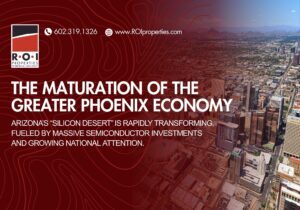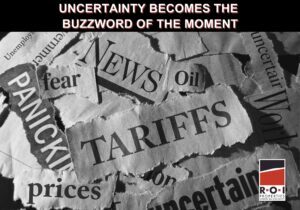Over the course of the next few weeks, we will be running a blog series called The Great Acceleration. The focus? Trends that have been pushed forward in commercial real estate sectors, from retail and entertainment to office, multifamily, hotels and industrial properties. To ensure that you are alerted when new articles come out, make sure to follow R.O.I. Properties on LinkedIn.
What’s Driving the Great Acceleration in Retail?
The trajectory of retail changed forever this month in 1995. From its humble launch as an online bookseller, Amazon has evolved into a 800-pound gorilla in every aspect of e-commerce, digital streaming, shipping, cloud computing, and even grocery shopping—topping $1 trillion in market capitalization early this year.
By the calendar, 25 years may seem like a long time. Looking at the dramatic changes that have happened over that period, however, the shockwaves reverberated fast and furiously through our retail and shopping malls. The so-called retail apocalypse, with countless bankruptcies and revenue declines at brick-and-mortar locations, began in 2010. Since then, e-commerce sales have been growing at an average of 15% annually, according to the U.S. Census. In 2019, the total market share of online U.S. retail sales was higher than general merchandise sales for the first time in history.
Then the coronavirus pandemic arrived, which is where the Great Acceleration comes into play, in aspects such as:
- Working around social restrictions. The advantage of e-commerce was clear from the moment shelter-in-place orders were announced. Even now, as restrictions are lifted, many consumers are choosing to order from the comfort of their home rather than heading to a store—particularly those with family members in high-risk health categories.
- Easy, fast, reliable shipping. Early in the COVID-19 pandemic, the supply chain had significant challenges, even to the point of restricting shipments to essential items at one point. Nonetheless, shipping has returned to being a convenient option for those who wish to avoid public spaces.
- Food delivery. Although grocery stores remained open as essential services, the pandemic saw increasing numbers of consumers turning to online ordering—leading to a record $7.2 billion in U.S. sales in June. Interestingly, a study found that 50% of in-store supermarket shoppers in the past 30 days also ordered groceries online.
- Contactless payment options. For brick-and-mortar stores, adapting to cashierless transactions is another trend that was happening at a reasonable pace, but was forced to accelerate with the desire to limit interpersonal contact.
Has Retail Real Estate Changed Permanently?
According to the research firm Competera: “In the US, as many as 29% of surveyed consumers state that they will never go back to shopping in person again.” To meet the surge in online demand, retailers such as Walmart, Amazon, Dollar Tree, and 7-Eleven hired an estimated 300,000 workers.
For now, brick-and-mortar stores have even more difficult challenges than they originally perceived with an upstart online vendor that changed the game for bookstores. Human beings are social animals, but depending on how long coronavirus persists, we simply cannot be as openly social as our nature might prefer.
As far as the retail real estate angle, construction starts in retail are the lowest the Phoenix market has seen in 10 years, according to CoStar, with just 118,000 SF in starts in Q1 and 100,000 SF in Q2. Vacancy rates have ticked up to 7.2%. On a national basis, retailers paid just under 60% of the rent owed to landlords during April and May. Recently, Forbes noted a trend of retailers asking for lease modifications, including percentage leases that consist of a base rent along with a percentage of monthly sales. LINK.
As with so many elements of COVID-19, the long-term effects will not be clear for years—but it is safe to say the unexpected changes have put immediate competitive stress on investors, retailers, and commercial property owners. Whether adopting new in-store technologies and hygiene safeguards, or increasing their online brand presence and sales, the need for agility and speed will be a matter of survival.
Even with the challenges of the Great Acceleration, there are reasons for optimism in retail real estate. For example, more than 80% of Target’s fulfillment orders are completed at stores. Ironically, it may be Amazon that ultimately “saves the mall,” as the company eyes portions of the J.C. Penney portfolio. The former retail giant’s big-box spaces would be ideal for distribution and fulfillment centers: well-located, large spaces, with large parking fields and good access to population bases and freeways. (LINK) In addition, do not be surprised if Amazon’s longer-term play incorporates grocery and physical retail elements—nor if other e-tailers take a similar tack, and take advantage of vacated physical retail spaces.
The Phoenix commercial real estate market is fast-moving—and our team is ready to help you meet the challenges. To put an expert advocate on your side for buying, selling, or leasing retail properties and other commercial real estate, contact R.O.I. Properties at [email protected] or 602-319-1326.










